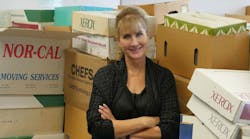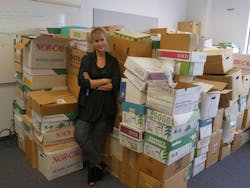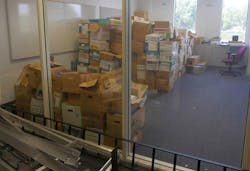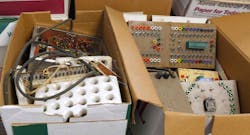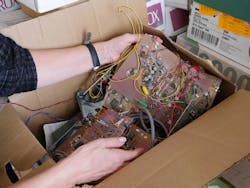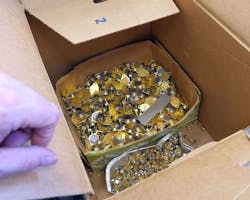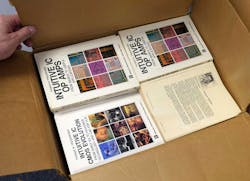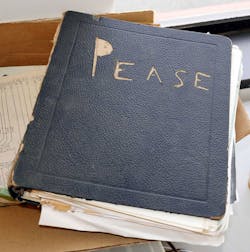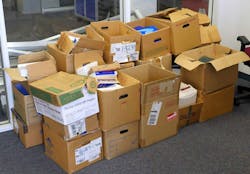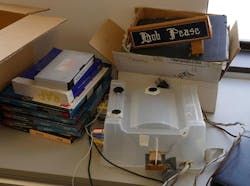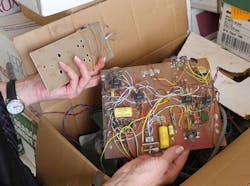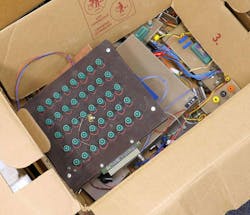While I visited the Texas Instruments Silicon Valley location in 2017, media relations manager Gayle Bullock (who is no longer with TI) was nice enough to show me all of the archived stuff from Bob Pease’s office, lab, home, and two storage units. Gayle was resigned to the monumental task of sifting through it all (Fig. 1). Her problem was she needed someone to help sift the wheat from the chaff. Pease had a lot of chaff. He routinely would make multiple copies of the same document. He was also a classic hoarder with that special affinity for paper and cardboard.
1. Gayle Bullock from Texas Instruments stands before a mountain of Bob Pease papers and hardware.
A Gobsmacking of Stuff
Retired Texas Instruments application engineer Alan Martin knew there was going to be a lot of stuff as he helped empty out Pease’s house. He was gobsmacked when Nancy, Pease’s lovely wife asked, “So do you know about the second storage unit?” With that added to the hundred boxes at her house, Pease’s stuff makes quite a mountain (Fig. 2).
2. The Pease hoard fills a conference room in Texas Instruments’ Silicon Valley location.
What’s fascinating is that the archive is not all paper. There are hand-built test boards that Pease used in his long and storied career (Fig. 3). Also in the pile are prototype boards Pease crafted to solve customers’ problems or evaluate first silicon (Fig. 4).
3. Pease’s hoard is not only paper. There are Pease prototypes and test rigs as well.
4. A classic example of Bob Pease’s “airball” prototyping.
Pease’s protege, Texas Instruments’ engineer Paul Grohe, told me that Pease once chided him for making a prototype too neat. Grohe relates, “Pease wanted everything spread out and messy so he could hack in and snip out components.” As well as the hardware, Pease had boxes full of parts, many in expensive metal can packaging (Fig. 5). One problem with these parts is they may be engineering prototypes and not production parts. They may all have to be scrapped.
5. There were boxes full of gold-plated regulators and amplifiers.
The treasure trove includes boxes of books. Pease had many copies of co-worker Tom Frederiksen’s books (Fig. 6). Frederiksen was a brilliant IC designer who come up with the ubiquitous LM324 quad op amp, as well as the LM3900 Norton amplifier. A lab manager told me he thought that Frederiksen was every bit as sharp as Bob Widlar; it’s just that Frederiksen was not so flamboyant. These books are still worth reading, Frederiksen had a great ability to make IC functions and applications clear to non-specialists.
6. A trove of Tom Frederiksen’s classic “Intuitive IC Op Amps” still has intrinsic value.
Some Pease Archaeology
Since Pease was a friend, I was especially touched by a notebook that he had carved his name into (Fig. 7). Less touching where the boxes of old databooks and other documentation (Fig. 8). Pease sure did love paper.
7. A lab notebook ring binder that Pease carved his name into so that it didn’t “walk off.”
8. Like any true hoarder, Pease loved paper. Old databooks and redundant documents abounded.
He also loved transparencies, which he called “analog PowerPoint” (Fig.9). Next to the boxes of transparencies is a wafer boat, used to house and transport silicon wafers. Pease used to love cutting them up and poking them full of holes. The four-pin tube-type plug makes this prototype a mystery.
9. A stack of overhead projector transparencies, which Pease called his “analog PowerPoint.” I gave the name plate to Paul Grohe. Note the prototype rig made from a 12-inch wafer boat.
Above the wafer boat is a script name plate. Gayle offered it to me, but I felt it was better going to Paul Grohe (check out Paul in the video below), Pease’s hand-picked protege who still works at this Texas Instruments location.
There are treasures aplenty. More hand-built prototypes emerged from a box (Fig. 10). Note that Bullock has an analog watch, just the thing when you work for an analog powerhouse like TI.
10. Another “airball” prototype. That they are doing a real function makes them quite the art project. Note the film capacitors that Pease loved for coupling, timing, and other analog functions.
Pease wore many hats. One of the circuit cards we found looks to be a burn-in board used in high-temperature testing of new parts (Fig. 11). By running the parts in an oven for extended times, Pease could help the process group qualify new IC fabrication methods.
11. In the early days of National Semiconductor, Pease often helped make burn-in fixtures and other setups for manufacturing.
Despite the towering hoard of boxes, Bullock was undaunted. She was working to get some engineers to sift through the material and at least discard the obsolete and irrelevant. She was a bit more unsure of what to do the with the hardware. She knew how to recycle the loose parts, but the hand-built boards are another issue. She hated to throw them away, since they are part of Pease’s legacy. I suggested that TI could give away the prototypes as they tour the world on their TI Tech Days seminars. Perhaps they can just have a display case to take on the road and rotate different Pease oddities into the case.
I loved seeing these Pease treasures. A lot of analog engineers would enjoy looking at them up close and personal. Let us know what you think TI should do with the hardware. Gayle gave some of it away at the 2019 Analog Aficionados party.
